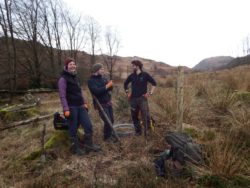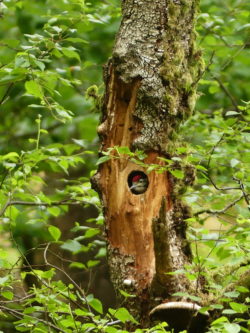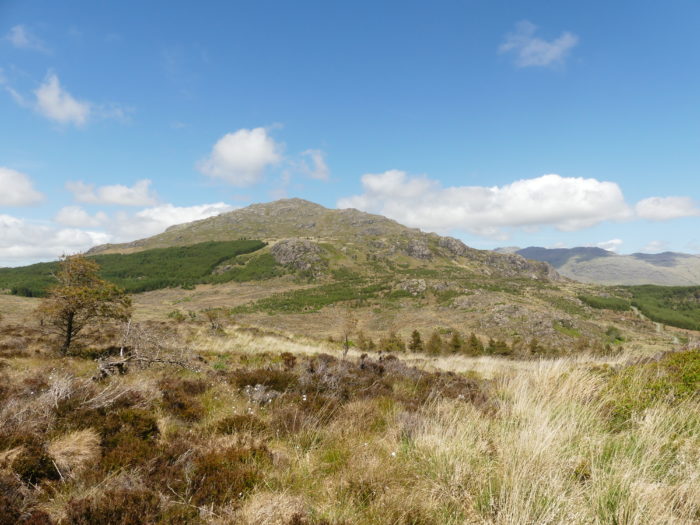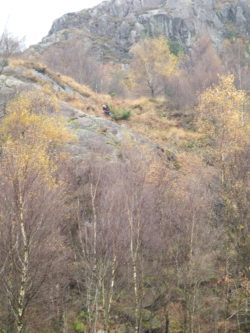What’s in a name?
"DISCUSSING DEFINITIONS FOR FORESTRY AND CONSERVATION" by Craig Holden, Project Assistant, November 2020
During the last year I’ve spent with Restoring Hardknott Forest I’ve been asked: “Is that the big forestry site in the Duddon Valley? Are you rewilding? Why don’t you plant more trees?”
This led me to think about the words and phrases used in relation to the work we do and to discuss a few of them. Language is dynamic, personal and contextual so this is a mix of definitions, connotations and opinion, without hopefully getting too bogged down in semantics.

Craig (centre) with Rob Jones, Forestry England (right) and Tasmin Fletcher, Project Assistant (left).
First off, what is a forest? ‘Forest’ in Middle English was an area designated for hunting, though woodland was not necessarily present. To some people today, forests often connote large plantations of non-native softwoods, as seen at Hardknott until felling began in the 1990’s. Forestry is defined as the broad science and work of cultivating, maintaining and developing forests and has multiple disciplines such as environmental forestry, forest ecology, social and urban forestry and silviculture. Silviculture is the branch of forestry concerned with the cultivation of trees, primarily for timber production, with the large plantations being many people’s primary experience of this. However forestry in the UK today delivers forests that are managed to provide multiple benefits alongside timber, such as habitats for wildlife and places for recreation.

Photo: Craig Holden
Afforestation is the creation of forests on land that was previously not forested. In the UK, afforestation of upland areas such as Hardknott largely began after the 1rst World War but the word originates from the 16th century, for the designation of land as royal hunting grounds. Reforestation is the establishment of forest cover in a location where forests have been cleared in the recent past. In many cases, deciding what ‘recent’ is may be difficult as historically their may have been native woodland cover before clearing, agriculture and then commercial plantations, but in practice these terms differ only slightly and are a good example of how meanings can evolve as perspectives on land use change.
Forestation occurs through either planting or natural regeneration, which is simply trees that have grown from a seed that has been naturally dispersed, either by wind, water or animals. At Hardknott we have lots of natural regeneration from both plantation and native tree species with seed sources on site or dispersed from nearby. By removing regenerated non-native trees, we help reduce competition for space in favour of the native broadleaves and therefore don’t need to do much planting for forest cover to increase. We do some enrichment planting of species that are not common on site, or where local seed sources are too isolated to help establish populations that will go on to regenerate.

Views of naturally regenerating woodland and plantation at Hardknott. Photo: Craig Holden
Natural regeneration of trees can be part of conservation and restoration projects. In general terms, conservation is the preservation or protection of something, whilst restoration returns it to a previous state. Nature conservation may be seen by some as limited to maintaining the current degraded state of things whilst restoration recreates a better state; as I was once was told by a respected forest manager, “I’m not a conservationist, I’m an ecological restorationist!”
This sentiment is understandable as previous conservation efforts have not prevented large scale loss of wildlife, whilst restoration ecology is increasingly used to turn agricultural or industrial land to a more environmentally favourable condition. Conservation in the context of the natural world was in use by 1909 and this connotation of caring for wildlife precedes our current awareness of the extent of environmental degradation. It seems to be a matter of perspective, conserving a species (as in to prevent its loss from an area or extinction) might require restoration of lost habitat but alternatively, the conservation of habitat might help restore the species. Regardless, the important point is the ongoing interaction between species and their environment. At Hardknott we’re not aiming to replicate a previous landscape, but by expanding native woodland we restore the ecological complexity of the landscape and therefore create a healthier ecosystem.

Craig collecting juniper berries at Hardknott Forest. Is he conserving, restoring or rewilding?
This idea of restoring ecosystem function is the underlying principle of rewilding. First found in academic literature in the 1990s ‘rewilding’ was defined as the scientific argument for restoring big wilderness based on the regulatory roles of large predators, focusing on North America. In Europe rewilding has, rightly or wrongly, connotations of reintroductions, blanket forestation and land abandonment. Ideological arguments have arisen, such as how much human intervention or management is acceptable before calling a project ‘rewilding’. I think conflict has also occurred when rewilding is posed as against, or superior to, other conservation efforts or land uses (such as agriculture) that can benefit wildlife if done sensitively. Various books, social media groups and events have added to this ambiguity with experiences of the natural world (such as ‘digital detoxes’, spending time in woodlands or wild swimming) presented as ‘Rewilding the body’. I like how rewilding is inspiring people and challenges prescriptions of how nature should be managed, but in terms of my day to day practical work I need specific tools in the box: reintroductions, land abandonment, tree planting; each justified in a practical ecological context.
To help the environment, wildlife and people, I believe we need a range of approaches to accommodate sites of differing sizes, remits and compromises. The methods we use in aid of the environment should determine the words we use: not the words dictate the means. So what is our Restoring Hardknott Forest project? Is it forestry, conservation or a rewilding effort? It depends on who you ask - I don’t think the trees mind.
